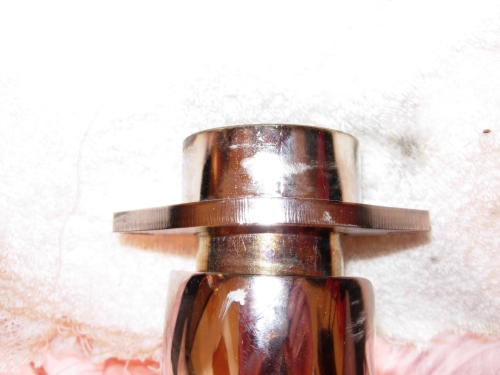Clinic
You CAN do it...
Straightening Bent Exhaust Flanges |

|
| Written by Randy Fox (Randysgym) | ||||||
| Monday, 02 March 2009 | ||||||
|
Page 7 of 7
Finishing Up
Now it's just a matter of putting everything back together. If your flanges have been removed from the pipes, slide them back onto the pipes before re-attaching the heat shields. Next, follow the manufacturer's instructions for loosely mounting the pipes. If you do not have access to decent instructions, then I would recommend you begin with the header section of the front pipe. Work it into place, being careful around the place where it passes between the floor-board and the engine cases. Use soft rags to protect scratching or touching. After positioning a new exhaust gasket into the exhaust port of the engine head, slide the flange onto the engine header studs. Hand thread the flange nuts, but do not tighten. Then do likewise with the header pipe section for the rear cylinder. Then attach the tail-pipe section, if your pipes have one, to the head-pipes and to the frame -- loosely. Note: If you have a three-pipe-section, you will need to loosely assemble all parts for both front and rear head-pipes before attaching the tail-pipe (if any). Once all parts are together, you can tighten everything up. Just be sure you use two principles as you tighten:
Of course, be especially aware to tighten the header flange nuts SPARINGLY. 3 or 4 ft-lbs of torque should be enough. Tip: The easiest way I've found to gauge this is to insert the long end of a long, 'L' shaped allen wrench into the flange nut. Use this by hand to snug the nuts down, little by little, as you continue to tighten everything up. Finally, after the flange nuts are hand-tight and all other fasteners have been tightened, use some linesman (blunt nose) pliers on the small end of the allen wrench to tighten a bit more. Tighten each flange nut about 1/2 turn more with the plier assisted allen wrench. Carefully and thoroughly clean the pipes and engine cases of all dirt and finger prints. Sometimes the heat can permanently etch fingerprints and smudges into chromed and/or painted pipes. If your pipes are chrome, be sure to use a very soft cloth, as it scratches VERY easily. Next, go for a ride. Pay special attention to the sound of deceleration. If, under hard deceleration, you hear popping sounds you may have one or more exhaust leaks that must be found and fixed. If you have an exhaust leak you should carefully examine where the leak might be coming from. To do this, you can look for signs of soot around the pipe joints, flanges, and surrounding areas. You can also try holding a smoke (cigarette or incense or something) close to pipe joints -- including around the exhaust gasket area -- while the engine is running. Tip: If your flange nuts thread onto the studs too far (due to thin flanges), or you are having trouble sealing exhaust leaks at the gasket area, you may find it useful to use two exhaust gaskets for each pipe. You may also find it helpful to use silicone exhaust sealant between the gaskets. See the Tools Needed section of this article for information on sealant, and the Parts Needed section for information on gaskets. Once the leaks have been found, wait for the pipes to cool before fixing them. Then go for another ride and listen again. Once you're comfortable no leaks exist, let the system cool down. Then check the flange nuts for tightness. The heating and cooling may have compressed the exhaust gaskets and worked the nuts loose, especially if you installed two gaskets per cylinder. Tighten as needed. Ride again for at least 15 or 20 minutes, until the engine and pipes have thoroughly warmed. Then let the pipes cool, and check the flange nuts for tightness again. If you feel they have come loose, tighten them down just a little more than you originally did, and go through the ride tests again. If all is well, check all the other nuts, bolts and screws of the exhaust system for tightness, one last time. You're good to go.
Questions should be asked in our forum (Use discuss link below). The forum is very active and you stand a good chance of getting your questions answered there. If you would like to leave feedback for the author, or have additional information you think will benefit others, please use the comment section at the bottom of this page. Discuss this article on the forums. (0 posts) DISCLAIMER: This information and procedure is provided as a courtesy and is for informational purposes only. Neither the publishers nor the authors accept any responsibility for the accuracy, applicability, or suitability of this procedure. You assume all risks associated with the use of this information. NEITHER THE PUBLISHERs NOR THE AUTHORs SHALL IN ANY EVENT BE LIABLE FOR ANY DIRECT, INDIRECT, PUNITIVE, SPECIAL, INCIDENTAL, OR CONSEQUENTIAL DAMAGES, OF ANY NATURE ARISING OUT OF OR IN ANY WAY CONNECTED WITH THE USE OR MISUSE OF THIS INFORMATION OR LACK OF INFORMATION. Any type of modification or service work on your motorcycle should always be performed by a professional mechanic. If performed incorrectly, this procedure may endanger the safety of you and others on your motorcycle and possibly invalidate your manufacturerís warranty.  Quote this article on your site | Views: 40535 Quote this article on your site | Views: 40535
Only registered users can write comments. Powered by AkoComment Tweaked Special Edition v.1.4.6
|
||||||
| New Forum Posts |
|---|
|
13 posts, last by:
Jaybo
2 posts, last by:
Jadams1911
13 posts, last by:
roadiemort
5 posts, last by:
Chromeinator
|
The Road Star Clinic is a collaborative community of riders who archive and publish user contributed technical data about Yamaha Road Star motorcycles.


 Comments (2)
Comments (2)